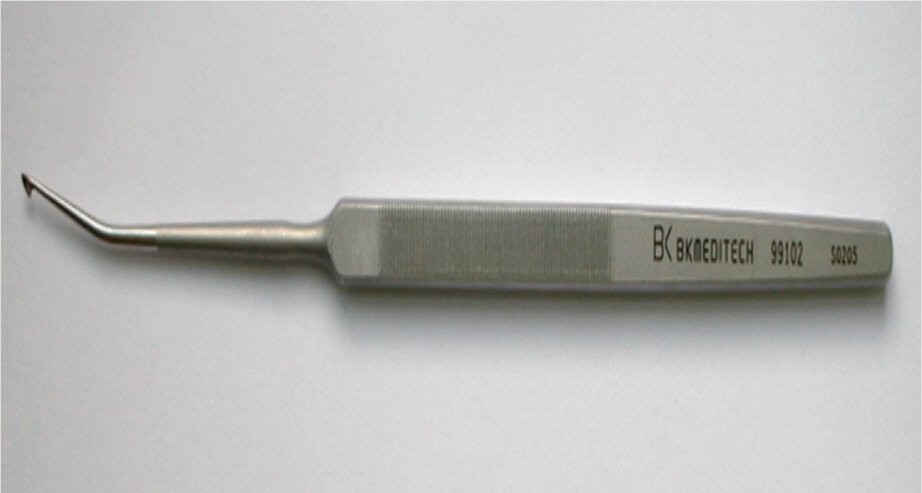J Korean Soc Surg Hand.
2016 Dec;21(4):218-224. 10.12790/jkssh.2016.21.4.218.
Ultrasound-Guided Percutaneous Release of the Trigger Thumb
- Affiliations
-
- 1Department of Orthopaedic Surgery, Dankook University College of Medicine, Cheonan, Korea. kimjp@dankook.ac.kr
- 2Department of Kinesiology and Medical Science, Graduate School, Dankook University, Cheonan, Korea.
- KMID: 2364213
- DOI: http://doi.org/10.12790/jkssh.2016.21.4.218
Abstract
- PURPOSE
Trigger thumb is a common condition with a prevalence rate up to 3% among the adults. The main pathophysiology is locking of the flexor tendon at the A1 pulley. Treatments include nonsteroidal anti-inflammatory drug, steroid injection, and surgical A1 pulley release. The purpose of this study was to evaluate the safety and effectiveness of ultrasound-guided percutaneous release of trigger thumb.
METHODS
The author prospectively reviewed 37 patients who had undergone ultrasound-guided percutaneous release by the same surgeon from January 2012 to June 2014. The effect of ultrasound-guided A1 pulley release was evaluated by using visual analogue scale (VAS) score, disabilities of arm, shoulder, and hand (DASH) score, and grip and pinch strengths preoperatively and at 12weeks after the surgery. In addition, complications related with the procedure were evaluated.
RESULTS
Triggering and locking were resolved in all patients after surgery. VAS and DASH improved from 5.0±1.8 and 45.8±16.9 preoperatively to 0.3±0.6 and 16.2±6.3 at 12 weeks, respectively (p=0.019 and p=0.021). Grip and pinch strengths statistically improved from33.5±8.6 kg and 36.7±8.1 kg, preoperatively 46.2±6.1 kg and 47.1±7.4 kg, respectively (p=0.026 and p=0.041). Complications such as incomplete resection, neurologic symptoms or wound infection were not found throughout the period of the study.
CONCLUSION
Ultrasound-guided percutaneous A1 pulley release provides complete relief of symptoms with no major complication in trigger thumb.
Keyword
MeSH Terms
Figure
Cited by 1 articles
-
A Prospective Study of Bowstringing after A1 Pulley Release of Trigger Thumb: Percutaneous versus Open Technique
Kwang-Hee Park, Jae-Uk Jung, Seok-Won Yang, Won-Jung Shin, Jong-Pil Kim
Arch Hand Microsurg. 2018;23(1):20-27. doi: 10.12790/ahm.2018.23.1.20.
Reference
-
1. Guler F, Kose O, Ercan EC, Turan A, Canbora K. Open versus percutaneous release for the treatment of trigger thumb. Orthopedics. 2013; 36:e1290–4.
Article2. Patel RM, Chilelli BJ, Ivy AD, Kalainov DM. Hand surface landmarks and measurements in the treatment of trigger thumb. J Hand Surg Am. 2013; 38:1166–71.
Article3. Wolfe SW. Tenosynovitis. Wolfe SW, Pederson WC, Hotchkiss MD, Kozin SH, editors. Green's operative hand surgery. 4th ed.Vol. 2. Philadelphia: Churchill Livingstone;2011. p. 2029–34.4. Sampson SP, Badalamente MA, Hurst LC, Seidman J. Pathobiology of the human A1 pulley in trigger finger. J Hand Surg Am. 1991; 16:714–21.
Article5. Maneerit J, Sriworakun C, Budhraja N, Nagavajara P. Trigger thumb: results of a prospective randomised study of percutaneous release with steroid injection versus steroid injection alone. J Hand Surg Br. 2003; 28:586–9.
Article6. Quinnell RC. Conservative management of trigger finger. Practitioner. 1980; 224:187–90.7. Calleja H, Tanchuling A, Alagar D, Tapia C, Macalalad A. Anatomic outcome of percutaneous release among patients with trigger finger. J Hand Surg Am. 2010; 35:1671–4.
Article8. Kim JP, Kim MH, Yoo MJ, Moon SY, Yoon SH. Percutaneous A1 pulley release of locked trigger thumb in children. J Korean Soc Surg Hand. 2010; 15:59–64.9. Ha KI, Park MJ, Ha CW. Percutaneous release of trigger digits. J Bone Joint Surg Br. 2001; 83:75–7.
Article10. Hudak PL, Amadio PC, Bombardier C. Development of an upper extremity outcome measure: the DASH (disabilities of the arm, shoulder and hand) [corrected]. The Upper Extremity Collaborative Group (UECG). Am J Ind Med. 1996; 29:602–8.11. Crosby CA, Wehbe MA, Mawr B. Hand strength: normative values. J Hand Surg Am. 1994; 19:665–70.
Article12. Will R, Lubahn J. Complications of open trigger finger release. J Hand Surg Am. 2010; 35:594–6.
Article13. Ryzewicz M, Wolf JM. Trigger digits: principles, management, and complications. J Hand Surg Am. 2006; 31:135–46.
Article14. Bamroongshawgasame T. A comparison of open and percutaneous pulley release in trigger digits. J Med Assoc Thai. 2010; 93:199–204.15. Chao M, Wu S, Yan T. The effect of miniscalpel-needle versus steroid injection for trigger thumb release. J Hand Surg Eur Vol. 2009; 34:522–5.
Article16. Wang H, Zeng H, Wu H, Shen Q, Cai C, Chen W. Percutaneous release of trigger finger with L shaped hollow needle knife. Zhongguo Xiu Fu Chong Jian Wai Ke Za Zhi. 2012; 26:14–6.17. Hirasawa Y, Sakakida K, Tokioka T, Ohta Y. An investigation of the digital nerves of the thumb. Clin Orthop Relat Res. 1985; (198):191–6.
Article18. Uras I, Yavuz O. Percutaneous release of trigger thumb: do we really need steroid? Int Orthop. 2007; 31:577.
Article19. Gilberts EC, Beekman WH, Stevens HJ, Wereldsma JC. Prospective randomized trial of open versus percutaneous surgery for trigger digits. J Hand Surg Am. 2001; 26:497–500.
Article20. Wilhelmi BJ, Mowlavi A, Neumeister MW, Bueno R, Lee WP. Safe treatment of trigger finger with longitudinal and transverse landmarks: an anatomic study of the border fingers for percutaneous release. Plast Reconstr Surg. 2003; 112:993–9.
Article21. Kim JP, Seo JB. The effect of steroid injection in percutaneous release of trigger fingers. J Korean Soc Surg Hand. 2007; 12:71–6.22. Patel MR, Moradia VJ. Percutaneous release of trigger digit with and without cortisone injection. J Hand Surg Am. 1997; 22:150–5.
Article23. Lorthioir J Jr. Surgical treatment of trigger-finger by a subcutaneous method. J Bone Joint Surg Am. 1958; 40:793–5.
Article24. Eastwood DM, Gupta KJ, Johnson DP. Percutaneous release of the trigger finger: an office procedure. J Hand Surg Am. 1992; 17:114–7.
Article25. Lyu SR. Closed division of the flexor tendon sheath for trigger finger. J Bone Joint Surg Br. 1992; 74:418–20.
Article26. Park MJ, Oh I, Ha KI. A1 pulley release of locked trigger digit by percutaneous technique. J Hand Surg Br. 2004; 29:502–5.
Article
- Full Text Links
- Actions
-
Cited
- CITED
-
- Close
- Share
- Similar articles
-
- Percutaneous A1 Pulley Release of Locked Trigger Thumb in Children
- A Prospective Study of Bowstringing after A1 Pulley Release of Trigger Thumb: Percutaneous versus Open Technique
- Percutaneous Release of Trigger Gingers
- Complex Regional Pain Syndrome Following Percutaneous Trigger Thumb Release
- Additional Pulley in the Two Cases of Trigger Thumb






